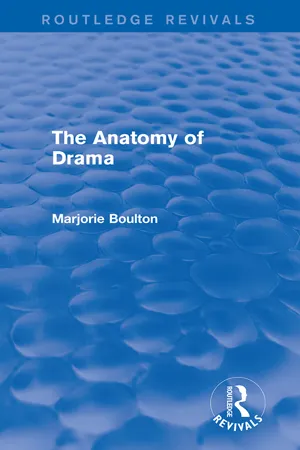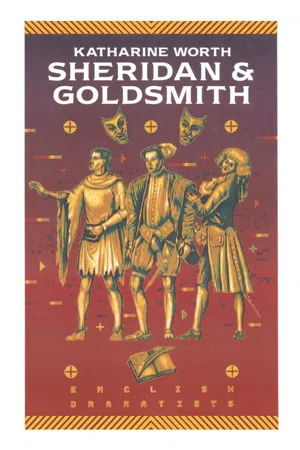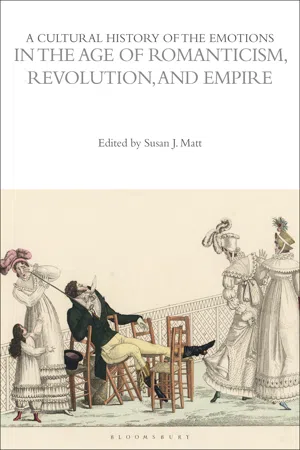Literature
Sentimental Comedy
Sentimental comedy is a genre of drama that emerged in the 18th century, characterized by its emphasis on emotions, moral values, and the portrayal of everyday life. It often features themes of love, virtue, and the triumph of good over evil, and typically includes elements of humor and sentimentality. This genre aimed to evoke empathy and moral reflection in its audience.
Written by Perlego with AI-assistance
3 Key excerpts on "Sentimental Comedy"
- eBook - ePub
- Marjorie Boulton(Author)
- 2014(Publication Date)
- Routledge(Publisher)
The Tender Husband is another play of this kind. The last two plays overlap into the next category.8. Sentimental Comedy
As its name implies, this is comedy which seeks to play to some extent upon our sympathies as well as making us laugh; it may even draw easy tears. It was, historically, a reaction against the coarseness and heartlessness of the brilliant but usually scandalous Restoration Comedy; but the genre is certainly far from extinct. Steele furnishes some of the best examples; other examples are Hugh Kelly's A Word to the Wise, which is more sentimental and less comic, and Isaac Bickerstaff's The Maid of the Mill and Love in a Village, two pretty comedies of excellent moral tone by an author whose character is said to have been scandalous! A modern example of some merit is Dodie Smith's Dear Octopus; Hollywood at its worst will provide abundant examples of this genre at its lowest.9. Comedy of Character or Humours
Here the chief comic interest is in the characters themselves—which is rather deeper and more difficult to convey than mere mannerisms and foibles. All Shakespeare's comedies are more or less comedies of character, just as they are all more or less comedies of errors. Jonson specialized in the comedy of humours, which is a kind of simplified comedy of character taking one point as characteristic to each person, so that we can have a jealous man, an ill-tempered man, a generous man, a lazy man and so on, but little complexity; this method was based on early physiological and psychological theories now known to be incorrect—though they were not stupid in their time. Whereas in tragedy we see people suffering because of their characters, in comedy we see them make fools of themselves because of their reactions to the comic situations; destiny in comedy brings out the humorous side of character. The treatment of character in comedy may range from the cynical and almost contemptuous, as in Jonson's The Silent Woman or Somerset Maugham's The Breadwinner, to the kindly and affectionate treatment of human fallibility as in As You Like It, Noel Coward's The Young Idea and Christopher Fry's Venus Observed. Sometimes in the comedy of character it is only the principal character who is really comic; for instance, in Molière's L’Avare only the miser Harpagon is really comic; the other characters, especially the young lovers, give the impression of being quite reasonable beings. Or, as in Jonson's comedies, all the characters may be comic. A good comedy of errors such as She Stoops to Conquer - eBook - ePub
- Katharine Worth(Author)
- 1992(Publication Date)
- Bloomsbury Academic(Publisher)
2 Why had comedy more or less banished the ‘pompous train’ and ‘swelling phrase’ of tragedy from the contemporary stage, he asked. Surely because comedy was more open to all kinds of people. It was the ‘natural portrait of human folly and frailty, of which all are judges, because all have sat for the picture’. ‘Natural’, that Rousseauesque word is, as so often with Goldsmith, the key word of praise. But there was a problem in copying from nature. She presents a ‘double face, either of mirth or sadness’ and contemporary writers, so he suggested, were ‘at a loss which chiefly to copy from’. Goldsmith was prepared to acknowledge that there was a serious debate taking place on the question ‘whether the exhibition of human distress is likely to afford the mind more entertainment than that of human absurdity’. The comment is not merely ironic. He knew (if only from Shakespeare) that comedy with sad or thoughtful aspects could entertain. And he admitted that ‘these sentimental pieces do often amuse us’. But his need to protect his own comic freedoms prevents him from doing more than glance at the radical shift of form implicit in the sentimental comedies of his time.That he recognised something of the radicalism (if only to find it damaging) is suggested by his summing up of the new genre: ‘a new species of dramatic composition has been introduced, under the name of sentimental comedy, in which the virtues of private life are exhibited, rather than the vices exposed; and the distresses rather than the faults of mankind make our interest in the piece.’A closer look at the distinguishing features of Sentimental Comedy may show how far from simple was Goldsmith’s relationship with the new genre. He had something in common with writers like Cumberland and Kelly as well as points of difference; inevitably, since Sentimental Comedy represented a deep change taking place in the national psyche. It was a response to eighteenth-century society’s wish to reform and refine itself, along lines which should appeal to us today. Plays such as The Clandestine Marriage, The West Indian and False Delicacy called on society to be fairer and kinder, especially in its treatment of women. The movement may have had its censorious, puritanical side but it also served a benevolent purpose by providing models of humane behaviour. Feminine sensibility was given more scope. Where Restoration playwrights had used satire to cast a mocking light on social absurdities and hypocrisies, usually from the perspective of witty young male characters, the sentimentalists liked to focus, as Goldsmith said, on the distresses caused by society’s unfairness. Marriage, that perennial problem, was put under a new spotlight, with a stronger emphasis on women’s suffering as victims of a hard-nosed, often hypocritical bourgeois society. Elopements and secret love matches loom large in plots and women characters’ attempts at rebellion are treated more softly and sympathetically than in the basically sardonic comedy of the Restoration. Romantic love comes to the fore, as in The Clandestine Marriage - Susan J. Matt, Susan J. Matt(Authors)
- 2020(Publication Date)
- Bloomsbury Academic(Publisher)
He sees it “as a narrative structure, in which the happiness and misfortune of the represented subject are the primary focus.” Yet sentimentality is also always about others, observers, and their emotional responses: “As well as representing a reality, the sentimental text represents the reaction to that reality of an observing subject” (Denby 1994: 4). Just as Denby broadens our understanding of sentimentalism to include suffering and happiness, observed and observer, Claudia Johnson has drawn attention to the whole range of emotions portrayed in sentimental texts. She characterizes the decade’s literary fiction as “bizarre and untidy”: “In works by Wollstonecraft, Radcliffe, Godwin, Lewis, and Burney (to name only a few), emotions are saturated in turbulent and disfiguring excess; not simply patently disruptive emotions—such as ambition, greed, anger, lust—but ostensibly gentler ones as well—such as reverence, sorrow, even filial devotion—are always and obviously going over the top” (C. Johnson 1995: 1–2). SENTIMENTALISM’S LEGACIES The literary texts that explored emotional excess most famously may have been those we now classify as “gothic.” The gothic is often separated from sentimentality because of the kinds of emotions it elicits: fear, terror, horror, and trembling rather than compassionate tears of sympathetic identification. Despite these evident differences, gothic and sentimental literatures are both reactions to neoclassical strictures and Enlightenment certainties. They’re both rooted in new understandings of psychology and the affective connections among individuals, and they both aim to stimulate readers’ sympathies
Index pages curate the most relevant extracts from our library of academic textbooks. They’ve been created using an in-house natural language model (NLM), each adding context and meaning to key research topics.
Explore more topic indexes
Explore more topic indexes
1 of 6
Explore more topic indexes
1 of 4


